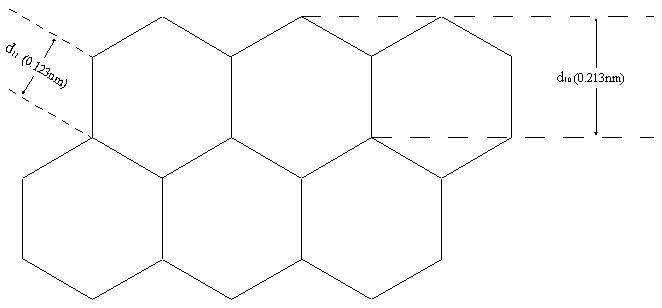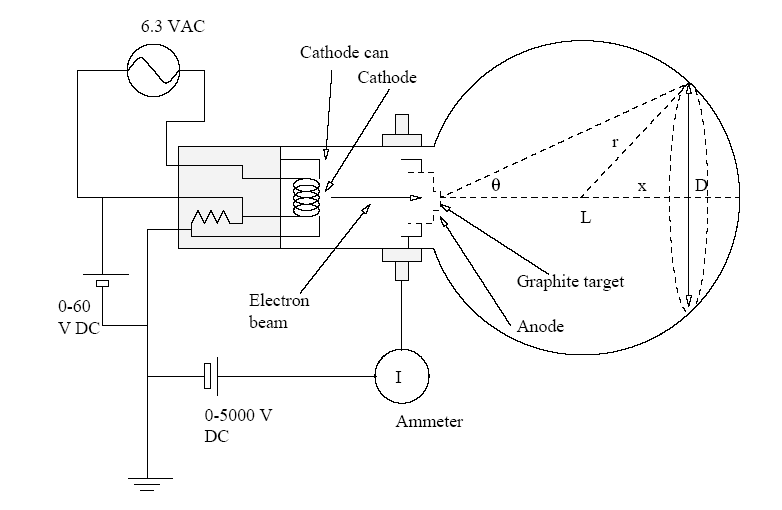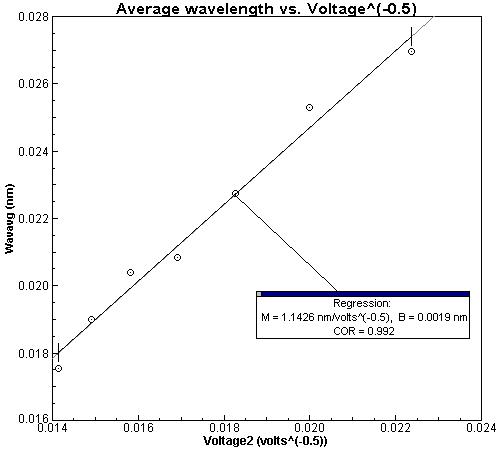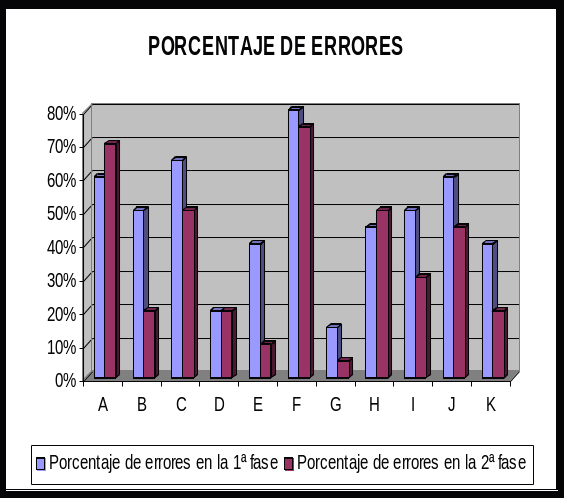DIFFRACTION OF ELECTRONS PURPOSE THE PURPOSE OF THIS LAB
10102018 THE DIFFRACTION GRATING TO MEASURE THE WAVELENGTH OF12 CRYSTALLOGRAPHYDIFFRACTION METHODS TEXTS DR ALLEN D HUNTER YOUNGSTOWN
ADVANCED POWDER DIFFRACTION ARE YOU GETTING EVERYTHING YOU CAN
APPLIED MODERN PHYSICS I XRAY DIFFRACTION TOPOGRAPHY AND
CHAPTER 35 INTERFERENCE AND DIFFRACTION CHAPTER 35 INTERFERENCE AND
CRYSTALLOGRAPHY AND DIFFRACTION COURSE ID CHEM 18 (3 CR)
Diffraction of Electrons
Diffraction
of
Electrons
Purpose
The purpose of this lab was to observe electron diffraction and understand the wave properties of electrons. The purpose was also to measure the diffraction effects of electrons as a function of energy and to verify the DeBroglie relation.
Introduction
 Similar
to light, electrons also have characteristics of particles and
waves. DeBroglie applied the wave theory to electrons and
called it the DeBroglie relation. The DeBroglie relation,
proved in the 1920’s, is:
Similar
to light, electrons also have characteristics of particles and
waves. DeBroglie applied the wave theory to electrons and
called it the DeBroglie relation. The DeBroglie relation,
proved in the 1920’s, is:
![]()
where p= momentum, h= Plank’s constant, and λ = wavelength.
The wavelike character of electrons predicts the energy levels of electrons in simple atoms. The electron has orbits that are orbits of standing waves where only certain wavelengths fit. Atomic spectra are explained by the wave properties of electrons.
 The
energy-momentum relation for non-relativistic elections
The
energy-momentum relation for non-relativistic elections
![]()
 is
substituted into the DeBroglie relation, we get the equation:
is
substituted into the DeBroglie relation, we get the equation:
![]()
If E = 2 keV, m = 0.511MeV/c2, h = 4x10-15 eVs, then the wavelength is equal to 0.8 nm. This wavelength is 1,000 times smaller than the wavelength of light; so optical diffraction gratings such as those used in previous lab experiments cannot be used in this experiment. Crystals provide a good grating with a magnitude of 0.2 nm.
In this experiment, electrons are produced using a vacuum tube and are accelerated to an energy between 2 keV and 5 keV. The electrons go through polycrystalline graphite. The structure of the crystal is like a hexagon as seen in the figure below.

The
spacings, d10
and d11,
were determined using X-ray diffraction. The polycrystalline sample
has crystallites at many different orientations to the incident
electron beam. The polycrystalline graphite is in three
dimensions. The diffraction peaks, therefore, form concentric
circles
around the direct beam. These circles are visible because of a
phosphor coating on the inside of the cathode ray tube.
It
was predicted that the wavelength of the electrons would drop and the
diameter of the circles would become smaller as the energy was
increased.
Procedure and Results
The ring diameter of the electron diffraction was measured for accelerating voltages between 2.0 kV and 4.0 kV in 0.5 kV intervals. The focus voltage was adjusted as large as possible to get a clear pattern. Calipers were used to measure the diameters in order to minimize electrostatic deflections. The wavelength was calculated using the equation l = dD/2L where d is the spacing, D is the diameter, and L for the Teltron 555 tube was 14.0 cm. The d11 spacing was used with the large diameter calculations and the d10 spacing was used with the small diameter calculations. Using the program, Graphical Analysis, the average wavelength was plotted against the voltage and the graph below was obtained.



In order to linearise the plot, the voltage was plotted as V-1/2. The graph of the average wavelength vs. voltage-1/2 is shown below.

 The
measured slope was 1.14 nm. The actual slope comes from the
equation:
The
measured slope was 1.14 nm. The actual slope comes from the
equation:
![]()
The
actual slope is 1.22 nm. The percent error between the lab
value and the actual value was 6.56%. The electron diffraction
in our experiment was similar to the actual diffraction of electrons.
Extracted from:
http://www.warren-wilson.edu/~physics/physics2/Formal_2001/JWood/Ediff.htm
CSSP DIFFRACTION SIMULATOR VERSION 33 SHAREWARE SOFTWARE TOOL FOR
DIFFRACTION TAKING LIGHT APART TEACHER GUIDE THIS SUITE
DIFFRACTION AT BIRD FEATHER TATJANA SAPTSINA TNSFIANSMRRU LEBEDEV
Tags: purpose the, the purpose, purpose, diffraction, electrons
- APOYO AL MUNDO DE LA CULTURA AUDI EN EL
- 2010 ANNUAL REPORT MARYLAND STATE POLICE FORENSIC SCIENCES DIVISION
- INGRESO RECAÍDA RETIRADA DEL CATÉTER FALLO DE LA TÉCNICA
- NORTHERN RAILWAY TENDER NOTICE NO25 2016 2017 HEADQUARTERS
- FORMATO PRADMVOCONALEP001PD02GT F1 CÉDULA DE ANÁLISIS DEL GRUPO DE
- PAGE 4 OF 4 CV OF LAWRENCE A BROWN
- NUMER SPRAWY ……………………………………… ……………………………………… DNIA ………………… R (MIEJSCOWOŚĆ) (DATA)
- EMPLOYEE REFERRAL FORM REFERRAL GUIDELINES 1 TO
- NÄR MIN FAR OCH MOR GIFTE SIG ÖVERTOGO DE
- CURRICULUM VITAE LAURA BOTTAZZI [MAY 2019] BOLOGNA UNIVERSITY DEPARTMENT
- EL HÁBITO DE LA LECTURA SE ADMITE COMO UN
- CRITERIOS PARA SELECCIONAR A NIÑOS CON NECESIDADES DE TERAPIA
- PART 1 CONTRACT DESCRIPTION JOB TITLE LEGACY CONSULTANT
- TEMARIO ESPECÍFICO DE LA ESTT OEP 2011 ESPECIALIDAD
- GUIA PARA EL USO DEL SISTEMA DE AGENDAMIENTO (USUARIO
- ODLUKA O UPISU UČENIKA U I RAZRED SREDNJE ŠKOLE
- 2018KO MARTXOAREN 8RAKO ADIERAZPENA EUS MUGIMENDU FEMINISTAK NAZIOARTEAN LANUZTEA
- CIBS CONFERENCE READING 2007 ABSTRACT GULF BUSINESS MODEL OTHER
- INTERNATIONAL LABOUR ORGANIZATION 1989 INTERNATIONAL LABOUR CONFERENCE RESOLUTION CONCERNING
- ISPITNA PITANJA IZ FIZIOLOGIJE BILJAKA ŠKOLSKA 201920 GODINA 1
- LAST UPDATED JULY 2014 FOOD ADDITIVES NUMERICAL LIST
- ERASMUS+ STAFF MOBILITY FOR TEACHING (STA) CONFIRMATION TO
- ALTERNATE TRANSPORTATION REQUEST THIS FORM MUST BE COMPLETED AND
- NOTICIAS GANA PROFESOR TAPATÍO BECA DE MICROSOFT CON UN
- B IBLIOGRAFIA SERGIO DI GIOIA “APORTES PARA UNA TEORÍA
- VALIDATE ROOT CAUSES PERFORMANCE CHALLENGE POSSIBLE ROOT CAUSE(S)
- JAUTĀJUMI UN ATBILDES PAR IEPIRKUMA PROCEDŪRAS NOLIKUMU “KANALIZĀCIJAS UN
- EMMA GOLDMAN EL TRATO INJUSTO A LOS HOMOSEXUALES
- ORGANIZATION NAME PARTICIPANT DETAILS IRCCS ASSOCIAZIONE OASI MARIA SS
- CENTRAL ALABAMA RADIATION ONCOLOGY LLC 4143 CARMICHAEL ROAD MONTGOMERY
 UN NUEVO SISTEMA DE EXPLICAR LA ACENTUACIÓN DEL ESPAÑOL
UN NUEVO SISTEMA DE EXPLICAR LA ACENTUACIÓN DEL ESPAÑOL FULFILLMENT INFORMATION FORM TO ENSURE TIMELY FULFILLMENT
FULFILLMENT INFORMATION FORM TO ENSURE TIMELY FULFILLMENTAPARTADO 4 MODELOS DE CALENDARIOS Y NORMATIVAS ESPECIALES EN
3 CERTYFIKAT „BEZPIECZNE PRZEDSZKOLE” CELEM WPROWADZENIA PROGRAMU JEST DOSKONALENIE
 RAMAZANSKI SAVJETI ZA ŽENE ] BOSANSKI – BOSNIAN –
RAMAZANSKI SAVJETI ZA ŽENE ] BOSANSKI – BOSNIAN – LINE 1 LINE 2 LINE 3 4 C 26
LINE 1 LINE 2 LINE 3 4 C 26NA TEMELJU ČLANKA 49 STATUTA GRADA MAKARSKE ( „GLASNIK
 ESERCIZI DI POTENZIAMENTO PER IL VASTO MEDIALE OBLIQUO DEL
ESERCIZI DI POTENZIAMENTO PER IL VASTO MEDIALE OBLIQUO DELMemoria Constructiva y Descriptiva Particular Proyecto de Licitación Para
5 THEMES OF GEOGRAPHY PROJECT DUE AUGUST 22 1
INTERNATIONAL FUNDERS FOR INDIGENOUS PEOPLES DISCURSO DE LA DRA
SOUTH CAROLINA GENERAL ASSEMBLY 115TH SESSION 20032004 H 3083
DATA WPŁYWU WNIOSKU (DZIEŃ MĄC ROK) POWIATOWE CENTRUM
 RECOMENDACIONES PARA ABRIR EL MANUAL DEL CURSO DE CORREO
RECOMENDACIONES PARA ABRIR EL MANUAL DEL CURSO DE CORREO T HE LOCAL GOVERNMENT PENSION SCHEME NOTICE OF RETIREMENT
T HE LOCAL GOVERNMENT PENSION SCHEME NOTICE OF RETIREMENT VSEM IZVAJALCEM ZDRAVSTVENIH STORITEV LJUBLJANA 16 11 2016 ZNAK
VSEM IZVAJALCEM ZDRAVSTVENIH STORITEV LJUBLJANA 16 11 2016 ZNAKAPPLICATION FORM MINIBUS DRIVER THE SCHOOL IS LEGALLY REQUIRED
 SPECIALTY TRAINING COMMITTEE IN RESPIRATORY AND SLEEP MEDICINE
SPECIALTY TRAINING COMMITTEE IN RESPIRATORY AND SLEEP MEDICINE  IFBJHQ SW 92001 ENCLOSURE ACKNOWLEDGEMENT OF RECEIPT OF INVITATION
IFBJHQ SW 92001 ENCLOSURE ACKNOWLEDGEMENT OF RECEIPT OF INVITATION MADRID 6 DE MAYO DE 2011 ABDÓN PEDRAJAS &
MADRID 6 DE MAYO DE 2011 ABDÓN PEDRAJAS &